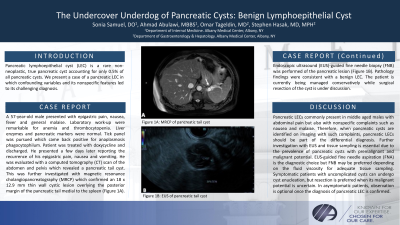Back


Poster Session B - Monday Morning
Category: Biliary/Pancreas
B0035 - The Undercover Underdog of Pancreatic Cysts: Benign Lymphoepithelial Cyst
Monday, October 24, 2022
10:00 AM – 12:00 PM ET
Location: Crown Ballroom

Has Audio

Sonia Samuel, DO
Albany Medical Center
Albany, NY
Presenting Author(s)
Sonia Samuel, DO1, Ahmad Abulawi, MBBS2, Omar Tageldin, MD1, Stephen Hasak, MD, MPH1
1Albany Medical Center, Albany, NY; 2Albany Medical College, Albany, NY
Introduction: Pancreatic lymphoepithelial cyst (LEC) is a rare non-neoplastic, true pancreatic cyst accounting for only 0.5% of all pancreatic cysts. We present a case of a pancreatic LEC in which confounding variables and its nonspecific features led to its challenging diagnosis.
Case Description/Methods: A 57-year-old male presented with epigastric pain, nausea, fever and general malaise. Laboratory work-up was remarkable for anemia and thrombocytopenia. Liver enzymes and pancreatic markers were normal. Tick panel was pursued which came back positive for anaplasmosis phagocytophilum. Patient was treated with doxycycline and discharged. He presented a few days later reporting the recurrence of his epigastric pain, nausea and vomiting. He was evaluated with a computed tomography (CT) scan of the abdomen and pelvis which revealed a pancreatic tail cyst. This was further investigated with magnetic resonance cholangiopancreatography (MRCP) which confirmed an 18 x 12.9 mm thin wall cystic lesion overlying the posterior margin of the pancreatic tail medial to the spleen (Figure 1A). Endoscopic ultrasound (EUS)-guided fine needle biopsy (FNB) was performed of the pancreatic lesion (Figure 1B). Pathology findings were consistent with a benign LEC. The patient is currently being managed conservatively while surgical resection of the cyst is under discussion.
Discussion: Pancreatic LECs commonly present in middle aged males with abdominal pain but also with nonspecific complaints such as nausea and malaise. Therefore, when pancreatic cysts are identified on imaging with such complaints, pancreatic LECs should be part of the differential diagnosis. Further investigation with EUS and tissue sampling is essential due to the prevalence of pancreatic cysts with premalignant and malignant potential. EUS-guided fine needle aspiration (FNA) is the diagnostic choice but FNB may be preferred depending on the fluid viscosity for adequate tissue sampling. Symptomatic patients with uncomplicated cysts can undergo cyst enucleation but resection is preferred when its malignant potential is uncertain. In asymptomatic patients, observation is optional once the diagnosis of pancreatic LEC is confirmed.

Disclosures:
Sonia Samuel, DO1, Ahmad Abulawi, MBBS2, Omar Tageldin, MD1, Stephen Hasak, MD, MPH1. B0035 - The Undercover Underdog of Pancreatic Cysts: Benign Lymphoepithelial Cyst, ACG 2022 Annual Scientific Meeting Abstracts. Charlotte, NC: American College of Gastroenterology.
1Albany Medical Center, Albany, NY; 2Albany Medical College, Albany, NY
Introduction: Pancreatic lymphoepithelial cyst (LEC) is a rare non-neoplastic, true pancreatic cyst accounting for only 0.5% of all pancreatic cysts. We present a case of a pancreatic LEC in which confounding variables and its nonspecific features led to its challenging diagnosis.
Case Description/Methods: A 57-year-old male presented with epigastric pain, nausea, fever and general malaise. Laboratory work-up was remarkable for anemia and thrombocytopenia. Liver enzymes and pancreatic markers were normal. Tick panel was pursued which came back positive for anaplasmosis phagocytophilum. Patient was treated with doxycycline and discharged. He presented a few days later reporting the recurrence of his epigastric pain, nausea and vomiting. He was evaluated with a computed tomography (CT) scan of the abdomen and pelvis which revealed a pancreatic tail cyst. This was further investigated with magnetic resonance cholangiopancreatography (MRCP) which confirmed an 18 x 12.9 mm thin wall cystic lesion overlying the posterior margin of the pancreatic tail medial to the spleen (Figure 1A). Endoscopic ultrasound (EUS)-guided fine needle biopsy (FNB) was performed of the pancreatic lesion (Figure 1B). Pathology findings were consistent with a benign LEC. The patient is currently being managed conservatively while surgical resection of the cyst is under discussion.
Discussion: Pancreatic LECs commonly present in middle aged males with abdominal pain but also with nonspecific complaints such as nausea and malaise. Therefore, when pancreatic cysts are identified on imaging with such complaints, pancreatic LECs should be part of the differential diagnosis. Further investigation with EUS and tissue sampling is essential due to the prevalence of pancreatic cysts with premalignant and malignant potential. EUS-guided fine needle aspiration (FNA) is the diagnostic choice but FNB may be preferred depending on the fluid viscosity for adequate tissue sampling. Symptomatic patients with uncomplicated cysts can undergo cyst enucleation but resection is preferred when its malignant potential is uncertain. In asymptomatic patients, observation is optional once the diagnosis of pancreatic LEC is confirmed.

Figure: Figure 1: (A) Magnetic resonance cholangiopancreatography (MRCP) of the pancreatic tail cyst. (B) Endoscopic ultrasound (EUS) of the pancreatic tail cyst.
Disclosures:
Sonia Samuel indicated no relevant financial relationships.
Ahmad Abulawi indicated no relevant financial relationships.
Omar Tageldin indicated no relevant financial relationships.
Stephen Hasak indicated no relevant financial relationships.
Sonia Samuel, DO1, Ahmad Abulawi, MBBS2, Omar Tageldin, MD1, Stephen Hasak, MD, MPH1. B0035 - The Undercover Underdog of Pancreatic Cysts: Benign Lymphoepithelial Cyst, ACG 2022 Annual Scientific Meeting Abstracts. Charlotte, NC: American College of Gastroenterology.
